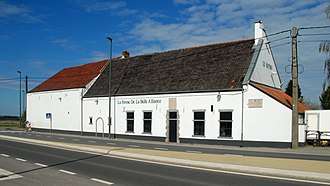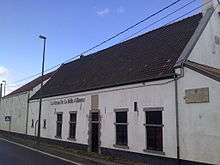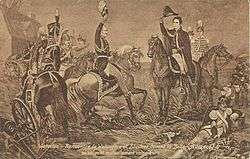La Belle Alliance
La Belle Alliance is an inn situated a few miles south of Brussels in Belgium, chiefly remembered for its significance in the aftermath of the Battle of Waterloo (18 June 1815).


There are two plaques on the building: one is "In memory of the French Medical Corps who attended the wounded with devotion on 18 June 1815"; and the other commemorates the meeting of the two victorious field marshals at the end of the Battle of Waterloo.[1]
Contemporary use
The building is currently used on Friday and Saturday evenings as a night club.
Battle of Waterloo

After the Battle of Waterloo, at around 21:00, Prince Blücher and the Duke of Wellington met close to the inn signifying the end of the fighting.[2] There is a large mural within the Palace of Westminster painted by Daniel Maclise in 1861 that depicts the meeting taking place at La Belle Alliance.[3][lower-alpha 1]
Blücher, the Prussian commander, suggested that the battle be remembered as la Belle Alliance, to commemorate the European Seventh Coalition of Britain, Russia, Prussia, the Netherlands, Sweden, Austria, Spain, Portugal, Sardinia, and a number of German States which had all joined the coalition to defeat the French Emperor. Wellington, who had chosen the field and commanded an allied army which had fought the French all day, instead recommended Waterloo, the village just north of the battlefield, where he himself had spent the previous night. Nevertheless, in 1815 the Rondell plaza in Berlin was renamed Belle-Alliance-Platz to commemorate the victory. There is a single La Belle Alliance Square in the UK, in Ramsgate, Kent.
.jpg) "La Belle Alliance, the centre of the French position". Engraver James Rouse
"La Belle Alliance, the centre of the French position". Engraver James Rouse.jpg) "View of La Belle Alliance". Engraver James Rouse
"View of La Belle Alliance". Engraver James Rouse.jpg) "View of La Belle Alliance". Engraver James Rouse
"View of La Belle Alliance". Engraver James Rouse
Name
According to J.B. Romberg who published an account of the locations around Brussels in 1820, originally La Belle Alliance consisted of three houses, one of which was a tavern, that now bears the name, and two adjacent houses. Some time before the Battle of Waterloo, the publican of the tavern died, and his widow married the occupier of Trimotion, the farm-house opposite; but losing him in a short time afterwards, she consoled herself by taking for her third husband a peasant who lived a house close by (now known as Decoster's house); but here again death interrupted her happiness, when she once more embraced the married state it was to marry the new landlord tavern; from which time it obtained the title it now bears.[4]
Notes
- The Edinburgh Review 1866, p. 14
Our readers are aware that considerable doubt has been thrown upon the time and place at which the meeting of the Duke of Wellington and Marshal Blücher took place after the battle, more especially by the erroneous declaration of the Duke himself that it occurred at Genappe, which, as we have shown in this Journal (Ed. Rev. vol. cxix. p. 168) was impossible, as Genappe was in the possession of the French till near midnight. We have, however, now before us some additional evidence on this interesting topic, which shows that Mr. Maclise's picture does not depart more widely from the truth of history than the license of art may fairly admit of. A formal declaration, which we have seen, has been drawn up by General Count Nostitz, who was personal aide-de-camp to Blücher in 1815, in which he states must positivity that the meeting of Blücher and Wellington did take place at La Belle Alliance—that the two generals congratulated each other there on their victory, and concerted measures for the pursuit of the enemy during the night. On the other hand, Sir William Gomm states that the meeting certainly did not take place at La Belle Alliance, but at a place so near it that the Prussians were justified in slightly extending the application of so appropriate a name. "The point of meeting", says Sir William, "was at or near to a small farmhouse or cabaret called 'Maison Rouge', on the roadside between 'La Belle Alliance' and Rossomme, a more considerable farmhouse and the furthest point on the road to which the Duke advanced. He was returning from it when the meeting took place". Lastly, the Duke himself said to Mr. Rogers (Rogers' Recollections, p. 212), "When all was over, Blücher and I met at "La Maison Rouge". The evidence is therefore decisive (as we had previously remarked) that La Maison Rouge was the real place of meeting, but the distance from La Maison Rouge to La Belle Alliance is inconsiderable, and the Duke was returning towards La Belle Alliance when he met Blücher on the road.
- Gillespie-Payne 2003, p. 166.
- Romberg 1820, p. 185.
- Westminster 2010.
- Romberg 1820, p. 186.
References
- Gillespie-Payne, Jonathan (2003), Waterloo: In the Footsteps of the Commanders, Pen and Sword, p. 166, ISBN 978-1-4738-2060-9
- Romberg, J. B. (1820), New picture of Brussels, p. 185–186
- "Article 1: Modern Fresco Painting", The Edinburgh Review, 73, New York: L. Scott, January–April 1866, p. 14
- "The Meeting of Wellington and Blucher after the Battle of Waterloo", UK Parliament, 20 April 2010, retrieved 22 September 2017
External links
| Wikimedia Commons has media related to Belle-Alliance. |
- "Ferme de la Belle-Alliance" (in French). wiki-braine-lalleud.be. 24 October 2015. — historical images of La Belle Alliance